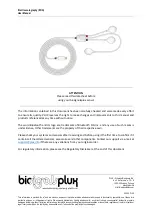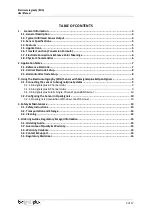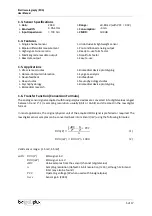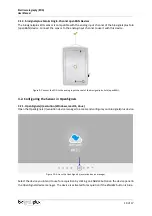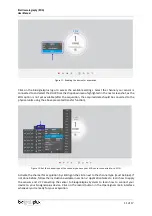
Electrooculography (EOG)
User Manual
5 of 17
1.3.
Sensor Specifications
> Gain:
2040
> Range:
±0.81mV (with VCC = 3.3V)
> Bandwidth:
0.05-41Hz
> Consumption:
~3mA
> Input Impedance:
> 100 G
𝛺
> CMRR:
100 dB
1.4.
Features
>
Single-channel sensor
>
Unobtrusive & lightweight sensor
>
Bipolar differential measurement
>
Pre-conditioned analog output
>
High signal-to-noise ratio
>
Ready-to-use form factor
>
Medical-grade raw data output
>
Small form factor
>
Raw data output
>
Easy-to-use
1.5.
Applications
>
Life sciences studies
>
Biomedical device prototyping
>
Human-Computer Interaction
>
Eye gaze analysis
>
Neurofeedback
>
Biofeedback
>
Sleep studies
>
Neurophysiology studies
>
Psychophysiology
>
Biomedical device prototyping
>
Biomedical research
1.6.
Transfer Function (Conversion Formula)
The analog sensor signals acquired with biosignalsplux devices are converted into digital values ranged
between 0 and 2
n
-1 (n=sampling resolution, usually 8-bit or 16-bit) and streamed in the raw digital
format.
In most applications, the original physical unit of the acquired EOG signal is preferred or required. The
raw digital sensor samples can be converted back into millivolt (mV) using the following formulas:
𝐸𝑂𝐺(𝑉) =
(
𝐴𝐷𝐶
2
𝑛
−
1
2) ∗ 𝑉𝐶𝐶
𝐺
(1)
𝐸𝑂𝐺(𝑚𝑉) = 𝐸𝑂𝐺(𝑉) ∗ 1000
(2)
Valid sensor range: [-1.5mV, 1.5mV]
with:
𝐸𝑂𝐺(𝑉)
EOG signal in V
𝐸𝑂𝐺(𝑚𝑉)
EOG signal in mV
𝐴𝐷𝐶
Value samples from the sensor/channel (digital value)
𝑛
Sampling resolution (default: 16-bit resolution (n=16), although 12-bit and
8-bit may also be found)
𝑉𝐶𝐶
Operating voltage (3V when used with biosignalsplux)
𝐺
𝐸𝐶𝐺
Sensor gain (2040)


